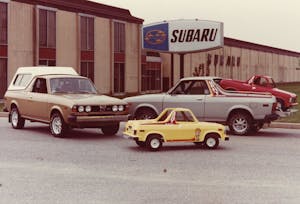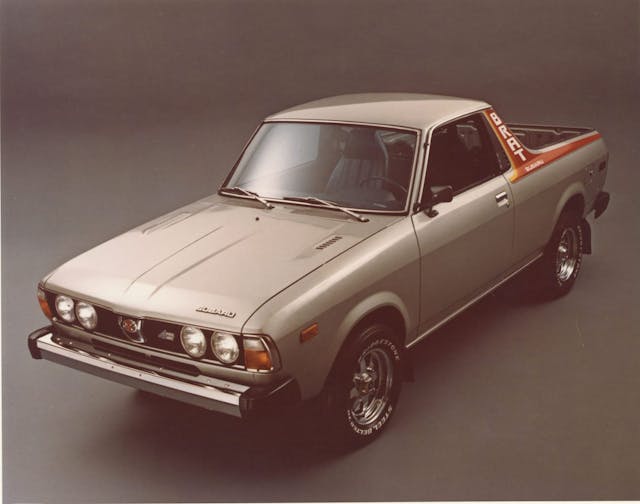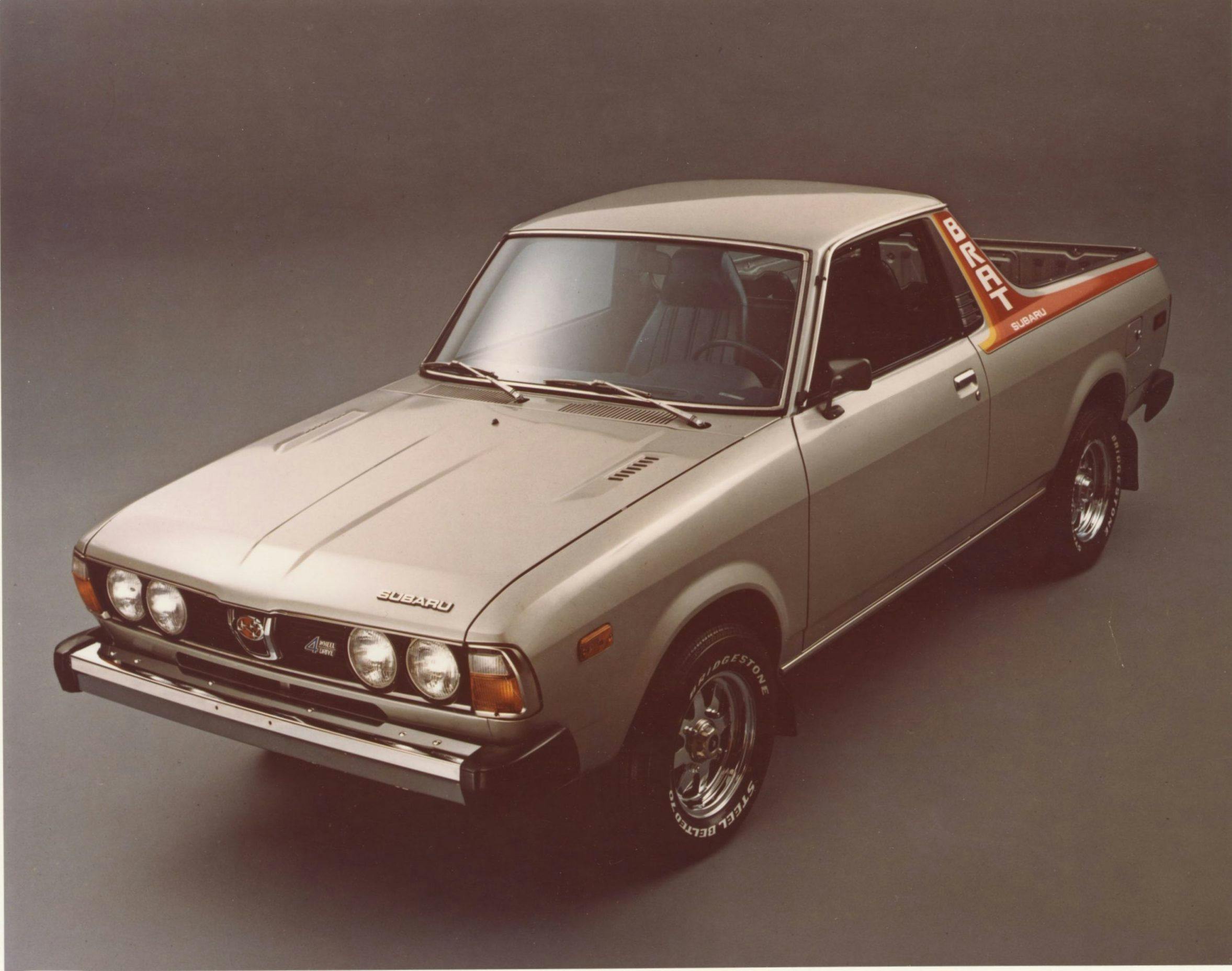Media | Articles
The 1978–93 Subaru BRAT is fun, functional, and climbing
America and Australia have a few things in common, despite being on opposite sides of the world. We’re both massive countries with wide stretches of open landscape. We both love cars—specifically muscle cars. And at one time, both countries had light trucks based on passenger cars, also called utes. America’s most popular ute was the Chevrolet El Camino, which ran through five generations from 1959 to 1987. By the late 1980s, America’s fascination with the ute dwindled as light trucks like the Ford Ranger and Toyota Pickup took over. Australia was able to keep the ute going another 30 years until the Holden Commodore finally ceased production in 2017, portending the end of the Holden brand altogether. El Camino values, for the most part, have been flat over the last several years, as the market has turned in favor Japanese cars over American muscle. In light of this shift, let’s take a look at Japan’s version of the ute: the Subaru BRAT.
By the late 1970s, the demand for small trucks in the USA was too great to ignore, and Subaru had to act quickly to take advantage. Instead of designing a truck from the ground up, the Japanese brand took its existing Leone station wagon platform and slapped on a truck body. Since Subaru was going up against other, bigger Japanese automakers in an already crowded space, the BRAT had to have a secret weapon—personality.
Even the name had attitude. In naming its new trucklet, Subaru committed the sin of the most forced acronym in automotive history. BRAT stood for “Bi-drive Recreational All-terrain Transporter.” (Subaru’s first choice—“Four-wheel-drive All-terrain Recreational Transporter”—wouldn’t work for obvious reasons.)
Subaru loaded the BRAT with features found on no other trucks at the time, starting with large rally-inspired decals flanking the B-pillar and running the length of the truck. The spare tire, oddly enough, was stored under the hood, behind the engine. BRATs also had an optional T-top roof that Subaru marketed as “halo-twin roof,” to which Ruth Gordon of Harold and Maude fame rolled her eyes and responded, “It’s a window!”
By far the weirdest feature of the BRAT were the rear-facing jump seats and carpeting in the cargo area. This allowed Subaru to take advantage of a tariff loophole by claiming the BRAT was a passenger car (which were taxed at under 3 percent) instead of a light truck (which were taxed at 25 percent). Upon taking delivery, most customers would remove the carpet because it was prone to hold water and cause rust. Many customers would also cut out the jump seats to make the cargo area usable—which makes BRATs with jump seats more desirable.
Marketplace
Buy and sell classics with confidence
The BRAT looks very rugged, but nobody should be fooled into thinking it’s a real truck. Despite it’s dual-range four-wheel-drive and manually adjustable ride height, it wasn’t a very capable off-roader. Hagerty staff learned this the hard way when we abused a 1984 BRAT in the California desert last summer. But you don’t buy a BRAT because it’s a good car, you buy it because it’s cool.
For nine glorious years from 1978 to 1987, the Subaru BRAT was sold in North America, while Europe and Australia got it until 1994. From 1978 to 1980, the only engine offered in the BRAT was Subaru’s 67-horsepower 1.6-liter EA-71 boxer-four. For the 1981 model year, around the same time the BRAT was given a facelift, Subaru increased the stroke of the little 1.6 liter, resulting in the 1.8-liter EA-81 boxer-four, which increased horsepower by only 8 percent, to 73 hp, and increased torque by 14 percent from 81 lb-ft to 94 lb-ft. While the BRAT only weighed 2200 pounds, it was still very underpowered. In Australia, “land of the utes,” Subaru fixed this problem by offering a turbocharged version of the 1.8-liter with 95 hp and 123 lb-ft of torque.

There’s no real value difference between pre- and post-facelift BRATs. While a 1980-or-earlier BRAT has the less powerful 1.6-liter and only a single-range transfer case, that powertrain is paired with more beautiful bodywork. Later models are perhaps less aesthetically blessed but have a more desirable spec with a larger engine and dual-range transfer case.
The only real value gap between model years results from Subaru’s decision to remove the cargo-bed jump seats after the 1985 model year. An Excellent (#2-condition) 1985 BRAT with the jump seats carries a 7.6 percent premium ($15,800 vs $14,600) over a 1986 BRAT sans jump seats.
As of late, BRAT values overall have been skyrocketing, but a good one is still very affordable. An excellent (#2-condition) 1985 Subaru BRAT GL has increased 48 percent over the last year (from $10,700 to $15,800) and up 126 percent since May 2017, when you could pick one up for an average of only $7000. All model years have followed this trend equally.

Around 100,000 Subaru BRATs were sold in North America, but you almost never see them anymore. The high attrition rate is not unexpected, BRATs were often used as work trucks and with the newest model years now over 30 years old, most have been driven into the ground. Also, while the BRAT was built in Japan, it was an export-only model for Subaru; the home Japanese market preferred station wagons over open-bed trucks. Thus, it’s common for Japanese enthusiasts to import BRATs from other countries, although they are probably most-often poaching RHD models from Australia.
It’s very rare to find a clean BRAT for sale, and when you do, you’re likely to encounter rabid enthusiasts willing to pay prices that some may find ridiculous. Whether they’re trucklet fans, Japanese-car diehards, Reagan historians, or just lovers of oddball vehicles, for some the juice is clearly worth the squeeze.
Like this article? Check out Hagerty Insider, our e-magazine devoted to tracking trends in the collector car market.














Who could ever forget the Subaru BRAT used as an R/C car, in “Manhattan Project”!? Though, as pointed out in the Hagerty piece from ’21, it didn’t fare well in actual off-road use, it remains an iconic design